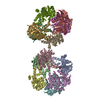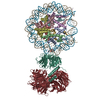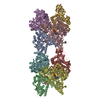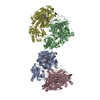+ Open data
Open data
- Basic information
Basic information
| Entry | Database: PDB / ID: 7e6u | |||||||||||||||||||||
|---|---|---|---|---|---|---|---|---|---|---|---|---|---|---|---|---|---|---|---|---|---|---|
| Title | the complex of inactive CaSR and NB2D11 | |||||||||||||||||||||
 Components Components |
| |||||||||||||||||||||
 Keywords Keywords | STRUCTURAL PROTEIN / G-protein-coupled receptor (GPCR) / Calcium-sensing receptor (CaSR) / cryo-electron microscopy (cryo-EM) / calcium ions / nanobody | |||||||||||||||||||||
| Function / homology |  Function and homology information Function and homology informationregulation of presynaptic membrane potential / bile acid secretion / chemosensory behavior / response to fibroblast growth factor / cellular response to peptide / cellular response to vitamin D / phosphatidylinositol-4,5-bisphosphate phospholipase C activity / Class C/3 (Metabotropic glutamate/pheromone receptors) / calcium ion import / positive regulation of positive chemotaxis ...regulation of presynaptic membrane potential / bile acid secretion / chemosensory behavior / response to fibroblast growth factor / cellular response to peptide / cellular response to vitamin D / phosphatidylinositol-4,5-bisphosphate phospholipase C activity / Class C/3 (Metabotropic glutamate/pheromone receptors) / calcium ion import / positive regulation of positive chemotaxis / fat pad development / cellular response to hepatocyte growth factor stimulus / amino acid binding / branching morphogenesis of an epithelial tube / positive regulation of calcium ion import / positive regulation of vasoconstriction / regulation of calcium ion transport / cellular response to low-density lipoprotein particle stimulus / anatomical structure morphogenesis / detection of calcium ion / JNK cascade / axon terminus / ossification / chloride transmembrane transport / response to ischemia / cellular response to glucose stimulus / G protein-coupled receptor activity / adenylate cyclase-inhibiting G protein-coupled receptor signaling pathway / positive regulation of insulin secretion / vasodilation / integrin binding / intracellular calcium ion homeostasis / presynaptic membrane / G alpha (i) signalling events / phospholipase C-activating G protein-coupled receptor signaling pathway / basolateral plasma membrane / cellular response to hypoxia / G alpha (q) signalling events / transmembrane transporter binding / positive regulation of ERK1 and ERK2 cascade / apical plasma membrane / G protein-coupled receptor signaling pathway / neuronal cell body / positive regulation of cell population proliferation / calcium ion binding / positive regulation of gene expression / protein kinase binding / glutamatergic synapse / cell surface / protein homodimerization activity / identical protein binding / plasma membrane Similarity search - Function | |||||||||||||||||||||
| Biological species |  Homo sapiens (human) Homo sapiens (human) Escherichia phage EcSzw-2 (virus) Escherichia phage EcSzw-2 (virus) | |||||||||||||||||||||
| Method | ELECTRON MICROSCOPY / single particle reconstruction / cryo EM / Resolution: 6 Å | |||||||||||||||||||||
 Authors Authors | Geng, Y. / Chen, X.C. / Wang, L. / Cui, Q.Q. / Ding, Z.Y. / Han, L. / Kou, Y.J. / Zhang, W.Q. / Wang, H.N. / Jia, X.M. ...Geng, Y. / Chen, X.C. / Wang, L. / Cui, Q.Q. / Ding, Z.Y. / Han, L. / Kou, Y.J. / Zhang, W.Q. / Wang, H.N. / Jia, X.M. / Dai, M. / Shi, Z.Z. / Li, Y.Y. / Li, X.Y. | |||||||||||||||||||||
| Funding support |  China, 2items China, 2items
| |||||||||||||||||||||
 Citation Citation |  Journal: Elife / Year: 2021 Journal: Elife / Year: 2021Title: Structural insights into the activation of human calcium-sensing receptor. Authors: Xiaochen Chen / Lu Wang / Qianqian Cui / Zhanyu Ding / Li Han / Yongjun Kou / Wenqing Zhang / Haonan Wang / Xiaomin Jia / Mei Dai / Zhenzhong Shi / Yuying Li / Xiyang Li / Yong Geng /  Abstract: Human calcium-sensing receptor (CaSR) is a G-protein-coupled receptor that maintains Ca homeostasis in serum. Here, we present the cryo-electron microscopy structures of the CaSR in the inactive and ...Human calcium-sensing receptor (CaSR) is a G-protein-coupled receptor that maintains Ca homeostasis in serum. Here, we present the cryo-electron microscopy structures of the CaSR in the inactive and agonist+PAM bound states. Complemented with previously reported structures of CaSR, we show that in addition to the full inactive and active states, there are multiple intermediate states during the activation of CaSR. We used a negative allosteric nanobody to stabilize the CaSR in the fully inactive state and found a new binding site for Ca ion that acts as a composite agonist with L-amino acid to stabilize the closure of active Venus flytraps. Our data show that agonist binding leads to compaction of the dimer, proximity of the cysteine-rich domains, large-scale transitions of seven-transmembrane domains, and inter- and intrasubunit conformational changes of seven-transmembrane domains to accommodate downstream transducers. Our results reveal the structural basis for activation mechanisms of CaSR and clarify the mode of action of Ca ions and L-amino acid leading to the activation of the receptor. | |||||||||||||||||||||
| History |
|
- Structure visualization
Structure visualization
| Movie |
 Movie viewer Movie viewer |
|---|---|
| Structure viewer | Molecule:  Molmil Molmil Jmol/JSmol Jmol/JSmol |
- Downloads & links
Downloads & links
- Download
Download
| PDBx/mmCIF format |  7e6u.cif.gz 7e6u.cif.gz | 324.5 KB | Display |  PDBx/mmCIF format PDBx/mmCIF format |
|---|---|---|---|---|
| PDB format |  pdb7e6u.ent.gz pdb7e6u.ent.gz | 260.2 KB | Display |  PDB format PDB format |
| PDBx/mmJSON format |  7e6u.json.gz 7e6u.json.gz | Tree view |  PDBx/mmJSON format PDBx/mmJSON format | |
| Others |  Other downloads Other downloads |
-Validation report
| Summary document |  7e6u_validation.pdf.gz 7e6u_validation.pdf.gz | 729.9 KB | Display |  wwPDB validaton report wwPDB validaton report |
|---|---|---|---|---|
| Full document |  7e6u_full_validation.pdf.gz 7e6u_full_validation.pdf.gz | 765.6 KB | Display | |
| Data in XML |  7e6u_validation.xml.gz 7e6u_validation.xml.gz | 53.5 KB | Display | |
| Data in CIF |  7e6u_validation.cif.gz 7e6u_validation.cif.gz | 80.5 KB | Display | |
| Arichive directory |  https://data.pdbj.org/pub/pdb/validation_reports/e6/7e6u https://data.pdbj.org/pub/pdb/validation_reports/e6/7e6u ftp://data.pdbj.org/pub/pdb/validation_reports/e6/7e6u ftp://data.pdbj.org/pub/pdb/validation_reports/e6/7e6u | HTTPS FTP |
-Related structure data
| Related structure data |  30997MC  7e6tC M: map data used to model this data C: citing same article ( |
|---|---|
| Similar structure data |
- Links
Links
- Assembly
Assembly
| Deposited unit | 
|
|---|---|
| 1 |
|
- Components
Components
| #1: Protein | Mass: 97326.094 Da / Num. of mol.: 2 Source method: isolated from a genetically manipulated source Source: (gene. exp.)  Homo sapiens (human) / Gene: CASR, GPRC2A, PCAR1 / Production host: Homo sapiens (human) / Gene: CASR, GPRC2A, PCAR1 / Production host:  Homo sapiens (human) / References: UniProt: P41180 Homo sapiens (human) / References: UniProt: P41180#2: Antibody | Mass: 15776.344 Da / Num. of mol.: 2 Source method: isolated from a genetically manipulated source Source: (gene. exp.)  Escherichia phage EcSzw-2 (virus) / Production host: Escherichia phage EcSzw-2 (virus) / Production host:  Escherichia phage EcSzw-2 (virus) Escherichia phage EcSzw-2 (virus)Has protein modification | Y | |
|---|
-Experimental details
-Experiment
| Experiment | Method: ELECTRON MICROSCOPY |
|---|---|
| EM experiment | Aggregation state: PARTICLE / 3D reconstruction method: single particle reconstruction |
- Sample preparation
Sample preparation
| Component | Name: CaSR / Type: COMPLEX / Entity ID: all / Source: RECOMBINANT |
|---|---|
| Source (natural) | Organism:  Homo sapiens (human) Homo sapiens (human) |
| Source (recombinant) | Organism:  Homo sapiens (human) Homo sapiens (human) |
| Buffer solution | pH: 8 |
| Specimen | Embedding applied: NO / Shadowing applied: NO / Staining applied: NO / Vitrification applied: YES |
| Vitrification | Cryogen name: NITROGEN |
- Electron microscopy imaging
Electron microscopy imaging
| Experimental equipment |  Model: Titan Krios / Image courtesy: FEI Company |
|---|---|
| Microscopy | Model: FEI TITAN KRIOS |
| Electron gun | Electron source:  FIELD EMISSION GUN / Accelerating voltage: 300 kV / Illumination mode: OTHER FIELD EMISSION GUN / Accelerating voltage: 300 kV / Illumination mode: OTHER |
| Electron lens | Mode: BRIGHT FIELD |
| Image recording | Electron dose: 70 e/Å2 / Film or detector model: GATAN K3 BIOQUANTUM (6k x 4k) |
- Processing
Processing
| Software | Name: PHENIX / Version: 1.18.2_3874: / Classification: refinement | ||||||||||||||||||||||||
|---|---|---|---|---|---|---|---|---|---|---|---|---|---|---|---|---|---|---|---|---|---|---|---|---|---|
| EM software | Name: PHENIX / Category: model refinement | ||||||||||||||||||||||||
| CTF correction | Type: PHASE FLIPPING AND AMPLITUDE CORRECTION | ||||||||||||||||||||||||
| 3D reconstruction | Resolution: 6 Å / Resolution method: FSC 0.143 CUT-OFF / Num. of particles: 1215058 / Symmetry type: POINT | ||||||||||||||||||||||||
| Refine LS restraints |
|
 Movie
Movie Controller
Controller











 PDBj
PDBj




